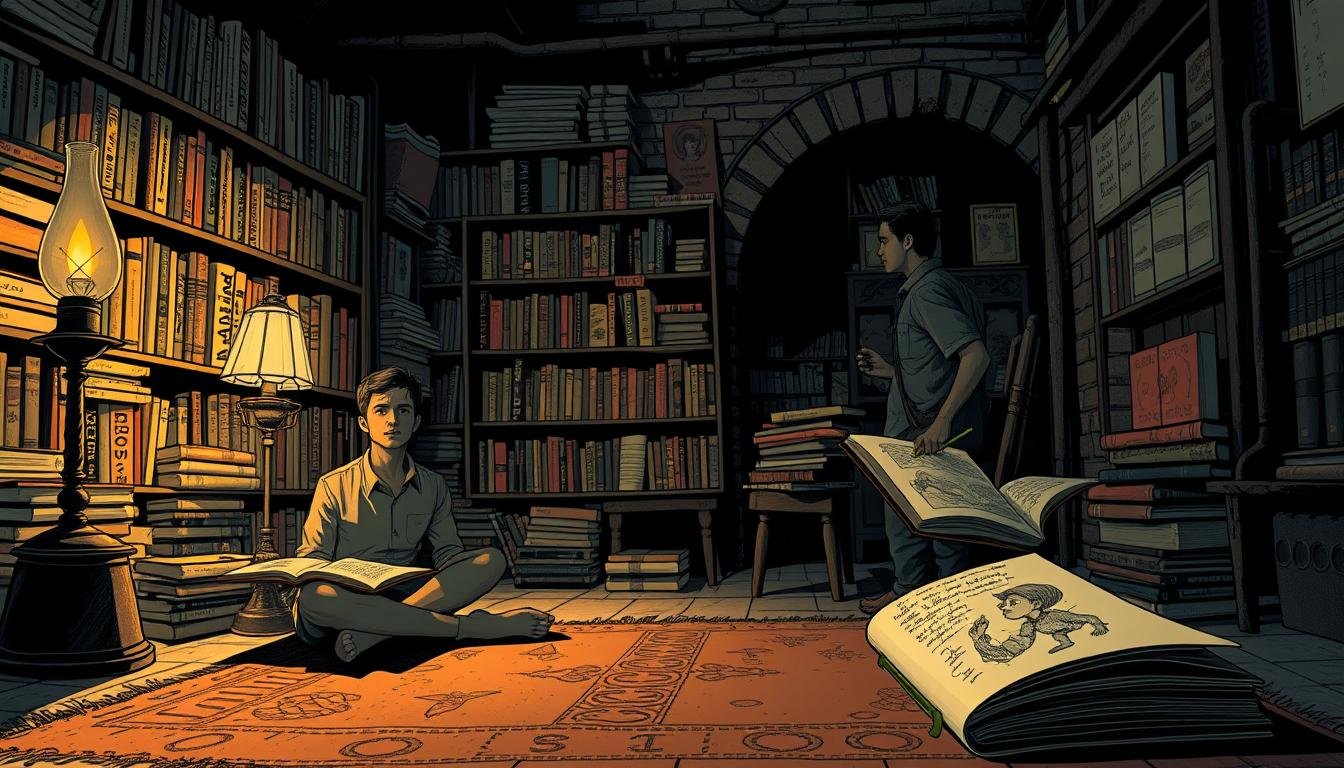Underground literature and poetry have long served as powerful forms of expression, challenging norms and reshaping cultural narratives. From oral traditions to digital platforms, this art form has evolved, reflecting the struggles and aspirations of marginalized voices.
Historically, underground movements have thrived in times of censorship and repression. Writers and poets used their craft to convey dissent, often at great personal risk. This writing not only preserved cultural identity but also inspired social change.
Today, underground poetry continues to flourish, blending traditional techniques with modern innovation. It remains a vital form of storytelling, connecting past and present. By exploring its rich history, we gain insight into the resilience of human creativity.
Key Takeaways
- Underground literature and poetry challenge societal norms.
- This art form has evolved from oral to digital traditions.
- Writers and poets often risked their lives to express dissent.
- Modern underground poetry blends traditional and innovative techniques.
- Understanding its history reveals the power of human creativity.
Introduction to the Underground Literature Movement
Rooted in defiance, underground literature emerged as a platform for marginalized voices to challenge societal norms. This movement thrives on rebellion, offering a raw and unfiltered perspective on culture and society. Unlike mainstream works, underground texts often explore themes of dissent, identity, and resistance.
Defining the Underground Aesthetic
The underground aesthetic is marked by its non-conformity and authenticity. It rejects polished narratives in favor of raw, unfiltered language. This term encompasses works that challenge traditional definitions of art and storytelling.
For example, underground books often feature unconventional structures and themes. These works resonate with readers seeking alternative perspectives. The underground aesthetic is not just a style; it’s a statement.
Cultural Roots in the Philippines
In the Philippines, underground literature has deep cultural roots. Historical and socio-political factors have shaped unique literary expressions. Writers often use their texts to address issues like colonialism, inequality, and identity.
For instance, during the Marcos regime, underground works became a tool for resistance. These books and poems preserved Filipino culture and inspired social change. Today, this tradition continues, blending traditional storytelling with modern innovation.
Comparing mainstream and underground literature reveals stark contrasts. While mainstream works often cater to commercial interests, underground texts prioritize authenticity and social commentary. This distinction highlights the power of non-conventional literature to inspire and provoke.
Historical Overview of Literary Traditions in the Philippines
The Philippines boasts a rich literary history that spans centuries, evolving from oral traditions to written masterpieces. This journey reflects the nation’s vibrant cultural heritage and resilience. Understanding this transition offers valuable insights into the roots of modern storytelling.
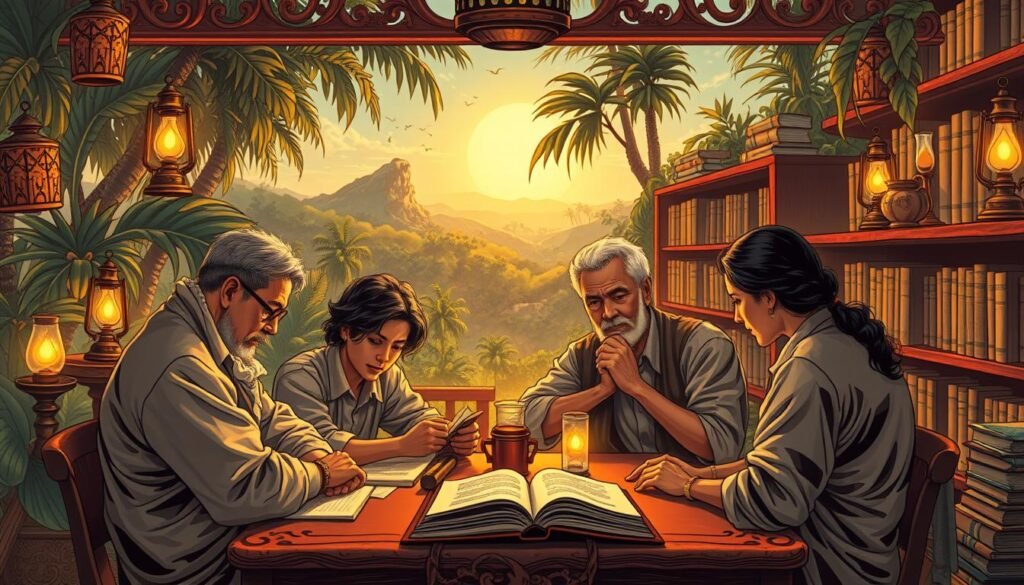
Tracing Oral to Written Transitions
Long before the written word, oral storytelling was the primary means of preserving history and culture. Ancient Filipinos used chants, epics, and folktales to pass down knowledge. These narratives were deeply rooted in communal life, serving as both entertainment and education.
The shift to written records began with the arrival of Spanish colonizers in the 16th century. Religious texts like the pasyon, first published in 1704, marked a significant milestone. These works were written in various local languages, blending indigenous traditions with foreign influences.
During the Propaganda Movement in the late 19th century, writers like Jose Rizal and Marcelo H. del Pilar used their works to advocate for reform. Their writings not only preserved Filipino identity but also inspired a sense of national pride. This period laid the foundation for modern Philippine literature.
Today, the study of these traditions reveals how oral narratives shaped written texts. From ancient epics to contemporary novels, the evolution of storytelling continues to influence Filipino authors. This rich legacy highlights the enduring power of the written word.
Evolution of Writing and Poetic Expression
From ancient epics to digital verses, the evolution of writing reflects the changing tides of culture and technology. Over time, poetry and storytelling have adapted to new mediums, reshaping how we express ideas and emotions. This transformation highlights the resilience and creativity of human expression.
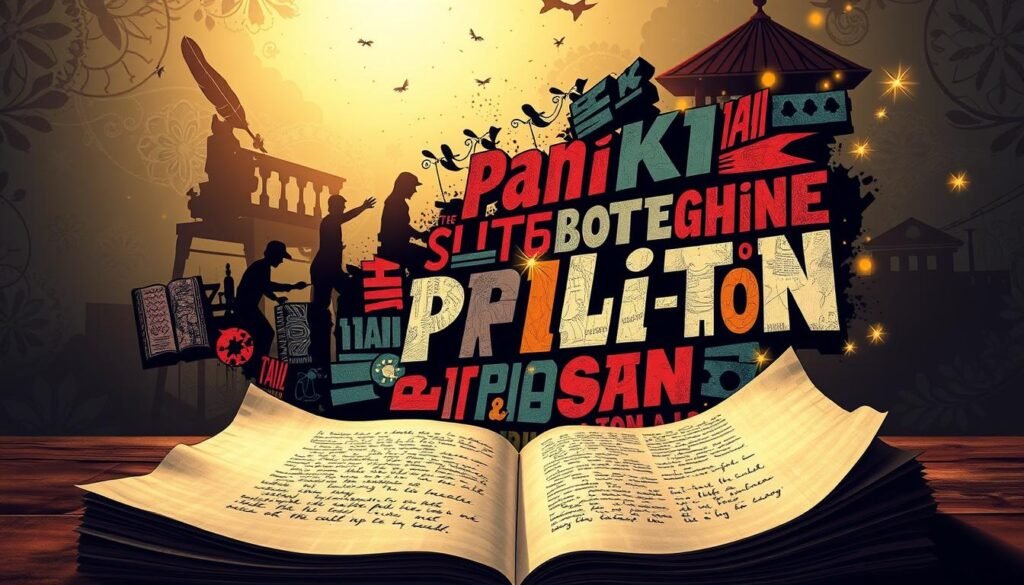
From Traditional Narratives to Modern Verses
Traditional narratives, rooted in oral traditions, laid the foundation for modern writing. Ancient epics like the Iliad and Beowulf were passed down through generations, preserving cultural identity. Today, these works inspire contemporary poets to reinterpret classic themes in innovative ways.
Modern poetry often blends old and new techniques, creating a unique style that resonates with today’s audience. For example, free verse has replaced rigid structures, allowing poets to explore deeper meaning and emotion. This shift reflects the evolving needs of society and the desire for authenticity.
In fiction and novels, the blending of traditional and experimental forms has opened new possibilities. Writers now use unconventional structures to challenge norms and provoke thought. This fusion of old and new highlights the dynamic nature of writing as an art form.
As technology advances, so does the way we create and consume poetry. Digital platforms have given rise to new forms of expression, from spoken word to interactive works. These innovations ensure that writing remains a vital part of our cultural landscape.
Ultimately, the evolution of writing and poetry underscores the power of creativity to adapt and thrive. By embracing both tradition and innovation, we continue to find new ways to tell our stories and connect with one another.
Literature: A Deep Dive into Art and Expression
The written word has always been a cornerstone of human expression, bridging cultures and generations. It serves as a vessel for transmitting cultural values and artistic merit, shaping how we understand the world. Through books, articles, and other forms of writing, ideas are preserved and shared, creating a lasting impact on society.

The Role of the Written Word
The written word plays a central role in preserving cultural and artistic content. From ancient manuscripts to modern articles, it captures the essence of human thought and creativity. This study of written works reveals how they influence cultural discourse and inspire new ideas.
Books are more than just stories; they are repositories of knowledge and emotion. They allow readers to explore different perspectives and gain a deeper understanding of the world. Similarly, articles provide concise yet impactful insights, often sparking debates and discussions.
Literary reviews further enhance this process by analyzing and critiquing written works. They offer a deeper study of themes, styles, and messages, helping readers appreciate the artistry behind each piece. This interplay between content, ideas, and critique enriches the literary landscape.
| Form | Role | Impact |
|---|---|---|
| Books | Preserve knowledge and stories | Inspire and educate readers |
| Articles | Provide concise insights | Spark discussions and debates |
| Reviews | Analyze literary works | Enhance understanding and appreciation |
Ultimately, the written word is a powerful tool for expression and connection. It transcends time and space, allowing us to share our stories and ideas with the world. By exploring its role in literary art, we gain a deeper appreciation for its enduring significance.
Underground Poetry as a Cultural Subversion
Underground poetry has always been a voice for the unheard, breaking barriers and redefining norms. This form of expression thrives in the shadows, challenging societal structures and amplifying marginalized perspectives. It’s more than just poetry; it’s a movement.
Through raw emotion and bold language, underground poets craft works that disrupt traditional narratives. Their texts often explore themes of resistance, identity, and freedom. This writing is not just art—it’s a call to action.
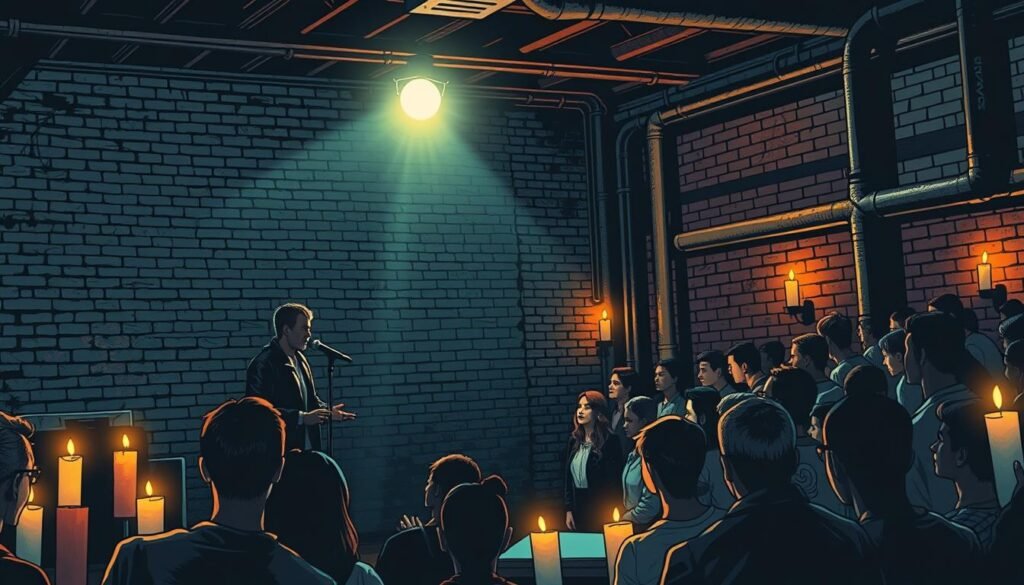
Key Underground Poets and Their Works
Many writers have left their mark on the underground scene. Their works blend innovative techniques with powerful messages. For example, some poets use fragmented structures to mirror societal chaos, while others employ vivid imagery to evoke emotion.
One notable author is example, whose texts challenge traditional forms of storytelling. Their work often includes elements of spoken word, creating a dynamic connection with the audience. This approach redefines what poetry can be.
Another influential writer is example, known for blending local dialects with global themes. Their language bridges cultural gaps, making their work accessible yet deeply personal. This fusion of styles is a hallmark of underground poetry.
These writers use their craft to provoke thought and inspire change. Their works are not just texts; they are tools for cultural subversion. By examining their form and language, we gain insight into the power of poetry as a force for transformation.
To learn more about the roots of Filipino writing, explore this guide to ancient Filipino script.
Technological Shifts and Publishing in the Digital Era
The digital era has revolutionized how we create, share, and consume written works. From the invention of the printing press to the rise of e-books, technology has continuously reshaped the publishing world. Today, the lines between traditional and digital formats are increasingly blurred, offering new opportunities and challenges.
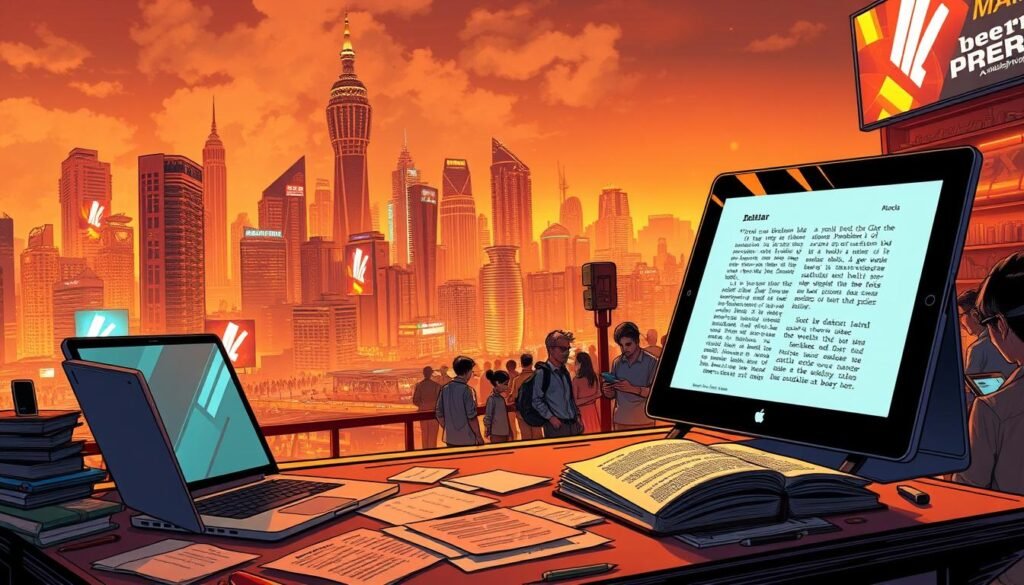
Impact of Print Innovations and Digital Media
Print innovations like the Gutenberg press laid the foundation for mass production of articles and books. This shift democratized access to knowledge, allowing ideas to spread across the world. Fast forward to the 21st century, and digital media has taken this transformation even further.
E-books, audiobooks, and online platforms have changed how we interact with written content. For instance, by 2015, e-readers and tablets were projected to reach 15% to 20% of the developed world. This shift has not only expanded access but also altered the course of literary production.
Blurring the Lines Between Online and Traditional Formats
Digital media has blurred the boundaries between online and traditional publishing. Today, an article can be published on a blog, shared on social media, and later printed as a book. This flexibility has redefined the use of written works, making them more accessible and versatile.
New organizational methods have also emerged, streamlining content distribution. For example, subscription services like Kindle Unlimited and Audible have changed how readers consume content. These platforms offer a vast library of books and audiobooks, catering to diverse tastes and preferences.
| Format | Impact | Example |
|---|---|---|
| E-books | Increased accessibility | Kindle, Nook |
| Audiobooks | Enhanced convenience | Audible, Spotify |
| Online Platforms | Global reach | Medium, Substack |
As media formats evolve, so does the theory and practice of literary reading. The rise of digital platforms has sparked new questions about the future of publishing. How will these changes shape the course of storytelling? Only time will tell.
Influential Figures in the Evolution of Underground Literature
The evolution of underground literature has been shaped by visionary figures who dared to challenge the status quo. These writers and poets, both local and global, have left an indelible mark on history, redefining the boundaries of expression and inspiring generations.
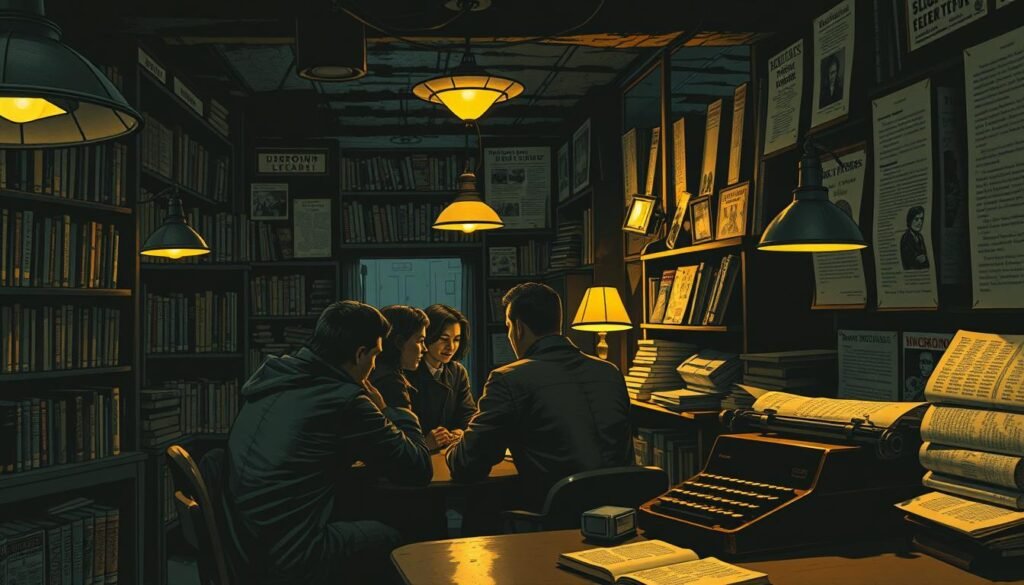
Local Trailblazers
In the Philippines, underground literature has been driven by pioneers who used their texts to address societal issues. For example, during the Marcos regime, writers like person risked their lives to produce works that challenged oppression. Their books became tools for resistance, preserving Filipino identity and sparking social change.
These local trailblazers often blended traditional storytelling with modern styles, creating a unique language of dissent. Their contributions not only enriched Filipino history but also inspired a new generation of writers to continue the fight for freedom through their texts.
Global Inspirations
Beyond the Philippines, global figures have also played a pivotal role in shaping underground literature. Authors like person from Russia and person from the United States have used their works to challenge societal norms and amplify marginalized voices. Their books and poems have transcended borders, influencing underground movements worldwide.
For instance, the history of American underground literature is deeply intertwined with cultural movements like the Beat Generation. Writers such as person and person redefined the style of storytelling, blending raw emotion with innovative techniques. Their works continue to inspire underground writers across the globe.
“Underground literature is not just about rebellion; it’s about giving a voice to those who have been silenced.”
These influential figures, both local and global, have shaped the history of underground literature through their courage and creativity. By examining their contributions, we gain a deeper understanding of how language, style, and texts can drive cultural change. To explore more about the evolution of literature, check out this guide to American literary periods.
Literary Criticism and Contemporary Perspectives
Literary criticism serves as a lens to decode the layers of meaning in written works. It evaluates artistic merit, explores definitions, and determines what becomes canonical. This process is both complex and dynamic, reflecting the evolving nature of storytelling.
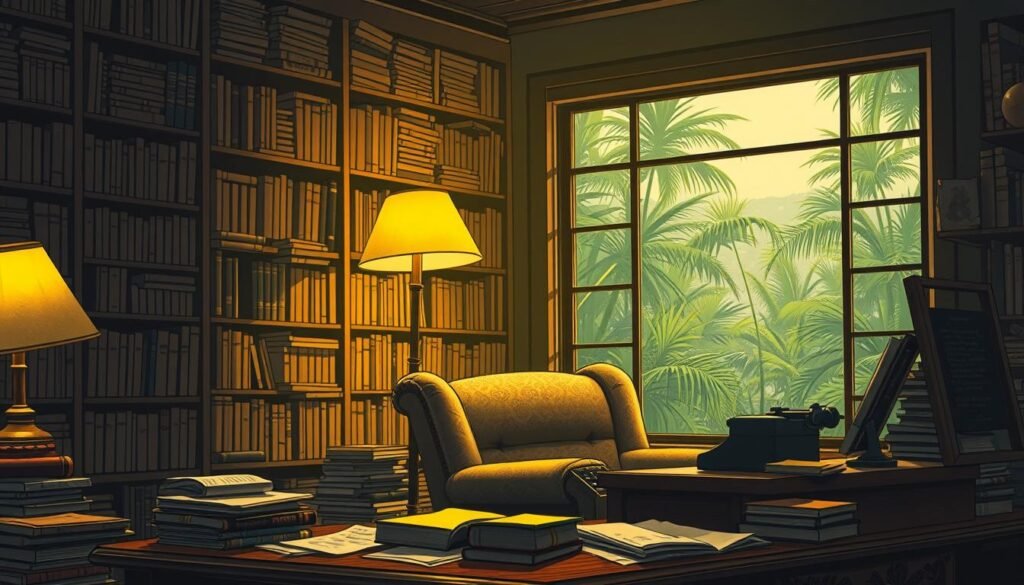
Evaluating Artistic Merit and Canonicity
Modern literary criticism focuses on the interplay between text and context. Critics analyze how fiction and other forms of writing resonate with readers. They use specific terms and instances to assess the enduring value of a work.
For example, a review might highlight the use of language to convey deeper meaning. This approach helps determine whether a work deserves a place in the literary canon. The process is often subjective, shaped by cultural and societal influences.
Historically, the 19th year marked a turning point in criticism. It became a distinct profession, with critics like Samuel Johnson shaping public perception. Today, the field continues to evolve, embracing diverse perspectives and methodologies.
“Criticism is not just about judgment; it’s about understanding the layers of a text and its impact on society.”
The role of fiction in shaping canonicity cannot be overstated. Works that challenge norms or explore universal themes often gain recognition. Critics play a key role in this process, offering insights that enrich our understanding of literature.
| Approach | Focus | Impact |
|---|---|---|
| Structuralism | Underlying structures | Reveals patterns in language and culture |
| Post-structuralism | Instability of meaning | Emphasizes reader interpretation |
| Reader-response | Reader’s role | Highlights subjective experience |
To delve deeper into the evolution of criticism, explore this guide to literary criticism. Understanding these approaches helps us appreciate the richness of literary works and their enduring significance.
Cross-Cultural Impact on Filipino Underground Poetry
The fusion of cross-cultural elements has deeply shaped the evolution of underground poetry in the Philippines. Drawing from global and local sources, this art form reflects a unique blend of influences, creating a powerful voice for marginalized communities.
Global literary trends have significantly impacted Filipino poetic styles. For instance, the Beat Generation’s raw emotion and free verse resonated with local writers, inspiring them to experiment with unconventional forms. This cross-pollination of ideas has enriched the texts, making them more relatable to a diverse reader base.
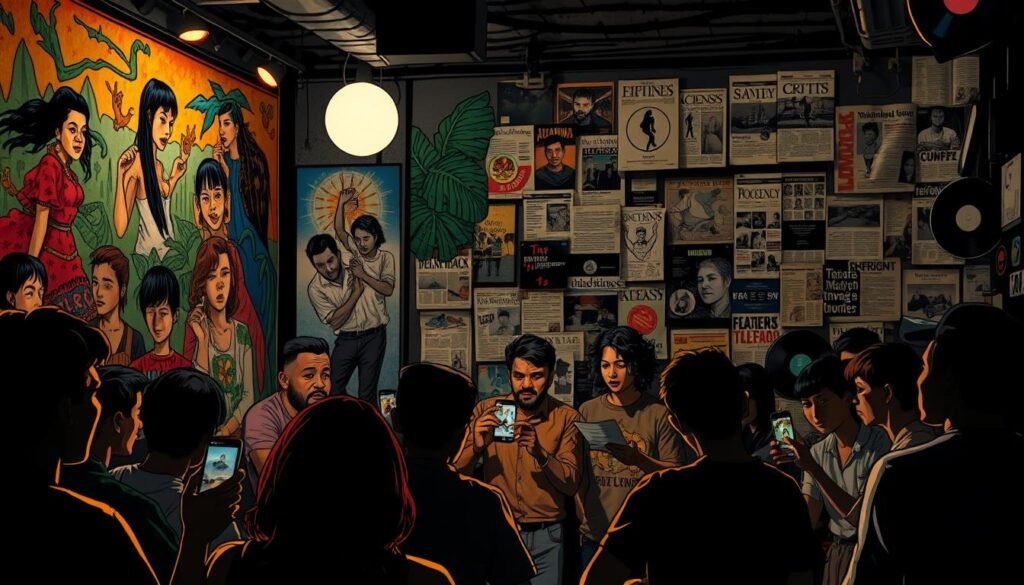
Elements of fiction and storytelling also intertwine across cultures. Filipino poets often weave local myths with global themes, creating a rich tapestry of art. This approach not only preserves cultural identity but also fosters a deeper connection with international audiences.
Literary terms and forms are reinterpreted in this cross-cultural context. For example, the traditional balagtasan (poetic debate) has been infused with modern themes, reflecting contemporary societal issues. This reinterpretation keeps the art form relevant and dynamic.
To explore more about the roots of this cultural fusion, delve into the rich history of Filipino cultural heritage.
| Influence | Impact | Example |
|---|---|---|
| Global Trends | Inspired experimental styles | Beat Generation’s free verse |
| Local Myths | Preserved cultural identity | Balagtasan with modern themes |
| Cross-Cultural Themes | Broadened reader appeal | Myths blended with global issues |
Through this cross-cultural lens, Filipino underground poetry continues to evolve, offering a unique perspective on universal themes. It remains a testament to the resilience and creativity of the human spirit.
Socio-Political Influences on Underground Literary Movements
Political upheaval has always been a catalyst for underground literary movements. These forms of expression emerge in response to censorship, oppression, and societal unrest. They serve as a voice for the marginalized, challenging dominant narratives and sparking change.
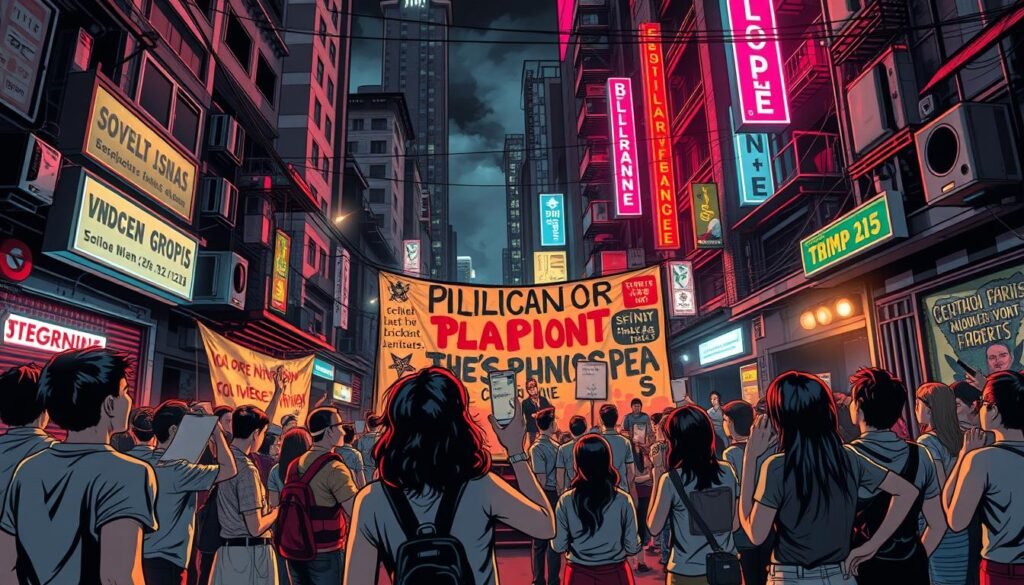
Throughout history, writers have used their words to critique power structures. For instance, during the Marcos regime in the Philippines, underground texts became a lifeline for dissent. These works preserved cultural identity while inspiring resistance against authoritarian rule.
Activism Through Art
Underground art is more than just creative expression; it’s a call to action. Poets and authors use their craft to address pressing issues like inequality, injustice, and freedom. Their works often blend raw emotion with powerful ideas, creating a lasting impact.
In the Philippines, underground fiction and poetry have played a crucial role in activism. Writers weave local myths with global themes, creating a unique form of storytelling. This approach not only preserves cultural heritage but also fosters a sense of unity among readers.
“Art is not a mirror to reflect reality, but a hammer with which to shape it.”
Globally, underground movements have challenged oppressive regimes. For example, during the Civil Rights Movement in the United States, literature became a tool for social protest. Writers used their words to amplify marginalized voices and inspire collective action.
- Underground literature challenges societal norms and power structures.
- It serves as a platform for marginalized voices to express dissent.
- Writers often blend traditional and modern techniques to create impactful texts.
- This art form inspires social change and preserves cultural identity.
To explore more about the role of literature in social movements, check out this guide to American civil rights literature.
The Interplay of Oral Tradition and Modern Writing Techniques
The blending of ancient oral traditions with modern writing techniques has created a dynamic fusion in storytelling. This synthesis preserves cultural heritage while adapting to contemporary forms of expression. From epic poems to digital narratives, the evolution of storytelling reflects the resilience of human creativity.
Oral traditions, rooted in communal sharing, have shaped the way we tell stories. These age-old methods, passed down through generations, continue to influence modern texts. For example, the use of vivid imagery and rhythmic patterns in oral storytelling has found its way into contemporary fiction and poetry.
Bridging Ancient Storytelling with Contemporary Styles
Modern writers often draw inspiration from oral traditions to create compelling narratives. Techniques like repetition and symbolism, common in oral storytelling, enhance the emotional impact of written texts. This fusion allows readers to connect with stories on a deeper level.
In the Philippines, the balagtasan (poetic debate) is a prime example of this blend. Traditional themes are reinterpreted to address modern issues, making the form relevant to today’s audience. This approach ensures that cultural heritage remains alive while adapting to changing times.
“Storytelling is the bridge between the past and the present, connecting generations through shared experiences.”
Globally, the influence of oral traditions is evident in works like Beowulf, which transitioned from oral recitation to written text. This evolution highlights the adaptability of storytelling across time and cultures.
- Oral traditions preserve cultural identity and inspire modern storytelling.
- Techniques like repetition and symbolism enhance written narratives.
- Traditional forms like balagtasan are reinterpreted for contemporary audiences.
- Global examples, such as Beowulf, showcase the evolution of storytelling.
To explore more about the interplay between oral and written traditions, check out this guide to oral tradition and its impact on modern literature.
Conclusion
Throughout history, storytelling has been a cornerstone of human connection, evolving to reflect the struggles and triumphs of society. Underground literature and poetry, as explored in this article, stand as powerful examples of this evolution. They challenge norms, preserve cultural identity, and inspire change, proving that art remains a vital force in shaping our world.
From traditional oral narratives to modern digital platforms, the form of expression has continuously adapted. Innovations in storytelling have blurred the lines between past and present, offering new ways to connect with audiences. This adaptability ensures that underground literature remains relevant, even in an ever-changing world.
As we reflect on its journey, it’s clear that this art form is more than just a medium of expression—it’s a testament to human resilience. To delve deeper into synthesizing insights, explore this guide on concluding literature reviews. Underground fiction and poetry will continue to evolve, inspiring generations to come.
FAQ
What defines the underground aesthetic in literature?
The underground aesthetic often challenges mainstream norms, focusing on raw, unfiltered expression. It thrives on subversion, authenticity, and often addresses marginalized voices or taboo subjects.
How did oral traditions influence Filipino literature?
Oral traditions laid the foundation for Filipino storytelling, passing down myths, legends, and cultural values. This transitioned into written forms, preserving the richness of local narratives.
Who are some key figures in underground poetry?
Prominent names include Amado V. Hernandez and Jose F. Lacaba, whose works blend activism with artistry, inspiring generations of Filipino poets.
How has technology impacted underground literature?
Digital platforms and print innovations have democratized publishing, allowing underground writers to reach wider audiences while blending traditional and modern formats.
What role does activism play in underground literary movements?
Activism is central, as underground literature often critiques societal injustices, empowering voices that challenge oppressive systems through art.
How does underground poetry bridge oral and written traditions?
It combines the immediacy of spoken word with the permanence of text, creating a dynamic interplay that honors ancient storytelling while embracing modern techniques.
What is the significance of cross-cultural influences in Filipino underground poetry?
Cross-cultural exchanges enrich the genre, blending local themes with global perspectives, fostering a unique and diverse literary identity.
Source Links
- The Soviet Underground and the Bard Generation : Literary Kicks
- The Literary Underground of the Old Regime — Harvard University Press
- An Interview with Bei Dao
- List of literary movements
- Underground Movements
- Political Mobilization and the Underground Literature of the Quit India Movement, 1942–44 | Journal of Public Policy | Cambridge Core
- The Literary Forms in Philippine Literature – National Commission for Culture and the Arts
- Philippine literature
- History of writing
- American Board
- Literature
- Why Study Literature
- Romanticism | Definition, Art, Era, Traits, Literature, Paintings, Artists, & Facts | Britannica
- Microsoft Word – underground (FORMAT).doc
- Libels in Action: Ritual, Subversion and the English Literary Underground, 1603–42
- Publishing in the digital era
- Platformization and Publishing: Changes in Literary Publishing – Publishing Research Quarterly
- Underground literature? The unofficial culture of the GDR and its development after theWende (Chapter 9) – Rereading East Germany
- Underground literature and its influence on youth in Turkey | New Perspectives on Turkey | Cambridge Core
- Notes From The Underground: The Rise and Fall of Russian Literature | Author, Daniel Kalder
- IJRTI
- Literary criticism
- Literary Criticism: An Introduction | Perspectives: Composition Through Understanding Literature
- Literary Movements: Timeline, Meaning & Events
- The role of literature in social movements in British India
- African literature – Oral Traditions, Modern Writers | Britannica
- Oral tradition | Storytelling, Cultural Preservation & Memory | Britannica
- LibGuides: How do I Write a Literature Review?: #5 Writing the Review
- What is the best way to conclude your literature review?

